 Search crowns look like a totem pole of 4 mouths topped with a red cap mushroom, the main body of varying orange and brown hues. Each mouth houses razor-sharp fangs. Standing a little over two feet tall, these fungi are normally easy to spot amongst other mushrooms in the area. – Imban
Search crowns look like a totem pole of 4 mouths topped with a red cap mushroom, the main body of varying orange and brown hues. Each mouth houses razor-sharp fangs. Standing a little over two feet tall, these fungi are normally easy to spot amongst other mushrooms in the area. – Imban
Search Crown (CR 2)
XP 600
TN Small Plant
Init +3; Senses low-light vision, tremorsense 30 ft.; Perception +0
DEFENSE
AC 15, touch 14, flat-footed 12 (+3 Dex, +1 natural, +1 size)
HP 16 [27] (3d8+3)
Fort +4, Reflex +3, Will +1
Immune mind-affecting effects, paralysis, plant traits, poison, sleep, stun
Resist fire 5
OFFENSE
Speed 10 ft.
Melee 4 bites +2 (1d4-1)
Ranged seed shot +6 (1d6+3)
Space 5 ft.; Reach 5 ft.
Special Attacks Four Laser, Seed Shot
STATISTICS
Str 8, Dex 16, Con 12, Int –, Wis 10, Cha 8
Base Atk +2; CMB +0; CMD 13
SPECIAL ABILITIES
Four Laser (Su)
Three times per day, a search crown can fire small bolts of homing energy from its four mouths. These bolts unerringly strike a single target within 130 feet, dealing 2d4+2 non-elemental damage as per the spell ruin.
Seed Shot (Ex)
A search crown is capable of firing a barrage of seeds as a standard action at will, dealing 1d6 bludgeoning and piercing damage, plus its Dexterity bonus, with a range increment of 100 feet.
Ecology
Environment forest or mountains
Organization solitary or pack (3–5)
Treasure none
Digging up from the ground, search crowns are often targeted by the local wildlife as common mushrooms or fungi to dine on, however if the search crown is aware of any predators they make quick work of them with their lasers and seeds. Often grouped up in pairs or clusters/troops of up to 5, the search crown is also known to team up with bagnadranas and needle kisses.
Search crowns look like a totem pole of 4 mouths topped with a red cap mushroom, the main body of varying orange and brown hues. Each mouth houses razor-sharp fangs. Standing a little over two feet tall, these fungi are normally easy to spot amongst other mushrooms in the area.

